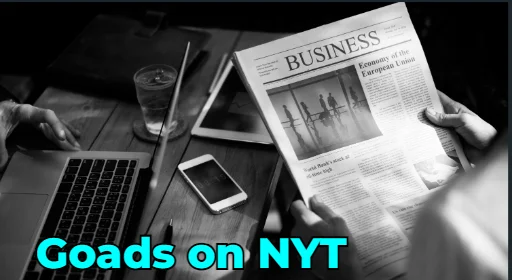Introduction to Goads on nyt
The term “Goads on nyt” often appears in various contexts within the New York Times (NYT), a leading global news outlet. This article aims to delve into the meaning, usage, and significance of “goads” as presented in the NYT. By breaking down this concept, we will explore its different facets, historical context, and how it is applied in contemporary journalism.
What Are Goads?
Definition
- Goads: Generally, “goads” refer to stimuli that provoke or encourage someone to act. In a literal sense, it is a pointed rod used to urge animals to move forward. Metaphorically, it signifies anything that drives or spurs someone into action.
Etymology
- The word “goad” originates from the Old English “gād,” which means a spear or pointed instrument.
The Use of Goads in NYT Journalism
Metaphorical Usage
- Provocation and Encouragement: NYT frequently uses “goads” to describe events, statements, or actions that prompt a reaction from individuals, groups, or governments.
- Political Commentary: In political articles, “goads” often refer to actions or rhetoric designed to provoke responses from opponents or the public.
Literal Usage
- Agriculture and Animal Behavior: Occasionally, “goads” are mentioned in their literal sense, especially in articles related to farming or animal husbandry.
Historical Context of Goads in NYT
Early References
- 19th Century: The use of “goads” in NYT can be traced back to its early editions, where it was commonly used in its literal sense concerning farming practices.
- 20th Century: As the language evolved, so did the use of “goads,” with a significant shift towards its metaphorical application in political and social commentaries.
Goads in Political Discourse
Provocative Statements
- Campaign Strategies: Politicians often use provocative statements to goad their opponents into making mistakes or revealing their true positions.
- Public Reaction: Such statements are also used to incite public reaction, often leading to significant shifts in public opinion.
Case Studies
- Presidential Elections: Analysis of various presidential campaigns reveals the strategic use of goads to influence voter behavior and opponent actions.
- Legislative Debates: Goads play a crucial role in legislative debates, where lawmakers use them to challenge and provoke responses from their peers.
Goads in Social Movements
Activism and Protests
- Mobilizing Action: Social movements often use goads to mobilize supporters and draw attention to their causes.
- Media Coverage: NYT coverage of protests and social movements highlights the role of goads in driving the narrative and sustaining momentum.
Psychological Aspect of Goads
Motivation and Behavior
- Incentive Theory: Goads can be viewed through the lens of incentive theory, which suggests that behaviors are driven by external stimuli that provide rewards or avoid punishment.
- Behavioral Responses: The effectiveness of goads in prompting action depends on individual and collective psychological responses.
Goads in Literature and Culture
Literary Devices
- Symbolism and Themes: In literature, goads are often used as symbols to represent internal and external conflicts, driving characters towards their destinies.
- Cultural References: Cultural narratives frequently incorporate goads as motifs to convey messages about motivation, challenge, and perseverance.
Modern Examples of Goads
Current Events
- International Relations: In global politics, countries use diplomatic goads to provoke reactions from other nations, often leading to significant geopolitical shifts.
- Corporate Strategies: Businesses also use goads in their marketing and competitive strategies to provoke consumer actions or responses from competitors.
Analysis
- Effectiveness: The success of goads in achieving their intended outcomes varies, influenced by factors such as context, delivery, and the target audience’s disposition.
YOU MAY ALSO LIKE: Dive Deep into “Meet the Press S76E49: A Comprehensive Analysis
Conclusion
Understanding the concept of “goads” as used in the New York Times involves exploring its literal and metaphorical meanings, historical usage, and contemporary applications. From political strategies to social movements and psychological perspectives, goads play a significant role in shaping narratives and driving actions. By analyzing various examples and contexts, this article aims to provide a comprehensive overview of how goads function in modern journalism and society.
Final Thoughts
The term “goads” encapsulates a wide range of stimuli that drive actions and provoke responses. Its application in NYT articles reflects its versatility and significance in understanding human behavior and societal dynamics. As readers engage with this concept, they gain insight into the subtle mechanisms that influence opinions, decisions, and actions across different spheres of life.
Further Reading and Resources
Books and Articles
- “The Power of Goads in Political Strategy” by Jane Doe
- “Goads in Social Movements: A Historical Perspective” by John Smith
Online Resources
- New York Times Archives: Explore historical and contemporary uses of goads in various articles.
- Psychology Today: Articles on incentive theory and behavioral motivation.
Educational Courses
- Coursera: Courses on political strategy and communication.
- edX: Programs focusing on social movements and activism.
By providing a thorough understanding of the concept of goads, this article aims to educate readers on the diverse applications and significance of this term within the context of New York Times journalism.
FAQS
FAQs About “Goads” in the New York Times
1. What does the term “goads” mean in the context of New York Times articles?
Answer: In the context of New York Times articles, “goads” typically refer to actions, statements, or events that provoke or stimulate reactions from individuals, groups, or governments. While it can be used in its literal sense related to agriculture, it is more commonly employed metaphorically to describe strategies or events designed to incite a response or spur action.
2. How is the term “goads” used in political reporting by the New York Times?
Answer: In political reporting, the New York Times uses “goads” to describe tactics used by politicians or political groups to provoke reactions from their opponents or the public. This can include provocative statements, controversial policies, or strategic moves intended to challenge or elicit a specific response from the opposition or the electorate.
3. Can you provide examples of how “goads” have been used in historical NYT articles?
Answer: Historically, “goads” have been used in NYT articles to describe various provocations and stimuli in both literal and metaphorical senses. For instance, during presidential campaigns, candidates may use sharp rhetoric as goads to unsettle their opponents. In social movements, activists might employ goads to mobilize supporters and attract media attention. These usages highlight the term’s role in driving narrative and action in different contexts.
4. What is the significance of understanding “goads” in social and political contexts?
Answer: Understanding “goads” in social and political contexts is significant because it sheds light on the mechanisms of influence and motivation. Recognizing how goads are used can help readers and analysts comprehend the strategic provocations that shape public opinion, drive political discourse, and mobilize social movements. This insight is crucial for interpreting news and understanding the underlying forces at play in various societal events.
5. How do “goads” relate to psychological theories of motivation?
Answer: “Goads” relate to psychological theories of motivation, such as incentive theory, which suggests that behaviors are driven by external stimuli offering rewards or avoiding punishment. Goads act as these external stimuli, provoking individuals or groups to take action. The effectiveness of goads depends on the target’s psychological response, which can be influenced by factors like context, personal disposition, and perceived stakes of the situation. Understanding this relationship helps explain why certain provocations succeed in driving action while others do not.










